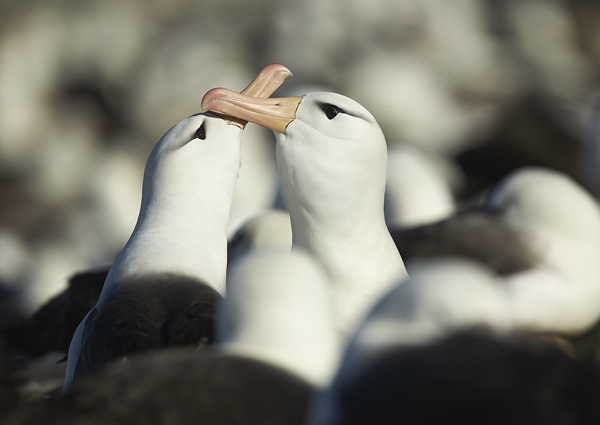In my last post here I talked about my high levels of excitement when spending a number of days photographing King Penguins during the course of my visit to the Falklands last year. They were only half of the story though in terms of my anticipation – the other half belonging fairly and squarely with the chance to spend some time in and among breeding Albatross.
There are 22 species of albatross, some 17 of which are classified as globally threatened. They are the ultimate sea-faring birds, spending huge amounts of their lives flying across the roughest seas of the planet, those that wrap themselves above the continent of Antarctica. They are the stuff of legends (think Coleridge’s Ancient Mariner) and for a long-term bird lover before taking it up professionally photographically, a further rite of passage.
During the 3 week trip, I had planned for us to visit two colonies of Black-browed Albatross, the predominant species of the Falklands and where some 70% of the worlds population actually breed. The first of these, the ice-breaker if you like, was a reasonably small colony but nicely located one and planned on a day when there would be no other visitors so we had the place completely to ourselves; it was on the island of West Point. After a short walk from the landing point with the local warden we reached the brow of a hill and looked down to the gathering below, perched almost perfectly on top of a dramatic coast line.
Like a white scar cutting through the surrounding tussock grass, an array of birds were perched on their cone-like nests, intermingled with Rockhopper Penguins filling in the spaces it seemed, all seemingly calling or clacking their beaks at each other; looking up the perfect early summer sky was full of gliding birds as well – all in all a truly uplifting sight.
After initially taking the scene in I felt I really needed some time to simply soak up what I had come to experience – we were going to be here all day so there was no rush – and so I made my way through some of the tunnels in the tussock grass to an extreme edge of the colony and found a single bird sitting patiently and simply sat down. My camera stayed in the bag for a full 30 minutes or so as I simply absorbed where I was and just how special it felt to be sharing this small corner of a remote island in the south Atlantic with this stunning bird. Who knows how far it had flown in its life to date – countless thousands of miles no doubt – or what weather and conditions it had experienced too; for now it was just the two of us here on the cliff top and both seemingly totally at ease with each other too. The camera dod come out of the bag eventually and I was treated to some great wide-angle images, an attempt on my part to really give a sense of just what it felt like to share this time and space.
As with all of the birdlife here, fear of human presence didn’t really seem to come into play so providing I showed respect and acted sensibly all the birds here remained very relaxed at all times.
The skies above were full of birds gliding too and fro and given a combination of their low flight paths and huge wing spans of some 2.5 metres I found myself in the unusual position of using a wide-angle lens to photograph them in flight too!
Throughout the day I found myself watching as much as photographing, enjoying the opportunity to capture simple portraits, little aspects of behaviour such as grooming, and given the incredible bonds that these birds have once they have committed to being a pair for life, the high levels of affection they demonstrated towards each other too.
West Point was an amazing place to spend the day with these beautiful birds – their naming extremely clear given the subtle striping across their eyes. It was though just the appetiser, because 24 hours later, given the opening in the weather that I had planned in hope for basing us at this western edge of the Falklands for a number of days to allow it to come, I was again on a boat and headed to the far north-west of the archipelago, a journey of some 6 or 7 hours, and to the remote and uninhabited island of Steeple Jason. This is a place that has long been very high indeed on my bucket list; it’s a challenge to get to (the boat journey is pretty much head on into the prevailing winds and they most certainly can blow down here, although local boatman Michael Clarke did a great job of getting us there and back safely – thanks) and totally uninhabited. With permission and accompanied by Rob McGill, the warden responsible for it though, we had a 48 hour opportunity to visit what is home to the largest colony of Black-browed Albatross in the world – some 200,000 pairs.
The shape of the island is testament to its location and the weather it has to cope with, it’s narrow high escarpment cutting down its centre like the scales standing proud on a dinosaurs spine.
Head to its westerly end though and after battling through the surrounding tussock grass, the sight (and sound) of the colony is simply breathtaking.
There are birds here as far as you can see – all of the white in the above shots are birds on the ground and in the same density as those in the foreground. A walk around the edge of the tussock grass you can see edging the colony here simply revealed more and more over the horizon and wrapping off towards the far side of the crags.
When faced with monumental choice like this it is very easy to be overwhelmed photographically. My first thoughts, and appreciating just how lucky we clearly were being in terms of the clear blue skies, was to capture the bigger picture – the setting and scale of these first two images. Sticking with the setting which is equally as breathtaking I then concentrated on some contextual portraits as well as looking to isolate individual birds with both long and short lenses, looking to work as creatively as I could with the light and angles available.
Before I knew it the sun was starting to set, warming the light but also casting shadows across the colony too so after one last set of shots it was time to retire briefly to the research hut and among the food that we had brought out with us the somewhat surreal option of Waitress frozen cheesecakes among the fare!
Sleep for me was brief, such was the level of adrenalin still flowing, and as the sun rose a few short hours later, we made our way round to the other side of the island to work with the new days light direction – effectively the other end of the colony. Again it involved a walk through the tussock grass (it is mostly over 3 metres high so a tussle to get through in places) and as this cleared and the rest of the colony was revealed the true scale of this place really hit home.
The white stripe here that is stretching out and round the far distant point is all breeding Albatross. The previous afternoon had been spent round the corner and none of these birds had been visible at all – they are all additional! The total colony stretches some two and a half miles around the coast here, and look in the far distance and you can see how it is starting to stretch up the side of the hill too. I have been lucky enough to visit some amazing seabird colonies in my life but nothing like this!
As the sun crept up into the sky, gradually lighting the colony, it was back to work with the combination of lenses looking to capture place, work with said light and isolate behaviour.
The interaction process is not only a reinforcement of the bonds of a relationship, but for the first season ashore in adulthood it is actually a process birds go through in terms of finding and selecting a life-long partner so it is a serious business of courtship too and a joy to watch.
Before I knew it it was mid-day (time flies so fast when you are completely absorbed) and time to leave: my 24 hours here was done and the long boat trip back awaited. After one last shot of the truly amazing scene the return journey was one full of reflection – what an experience, what a sight, what a stunning spectacle of the natural world and more than that what a privilege to have been able to experience it. Now I just can’t wait to go back: the birds will be returning to their colonies about now but for me it’ll be another 12 months until I get to go back but it’s most certainly worth waiting for.
























Those are stunning photos. It must have been great to have the birds so relaxed.
It was a quite surreal experience Kyle and certainly added to the magic of the place – that and just how stunning they are up close which no photos can really do justice to.